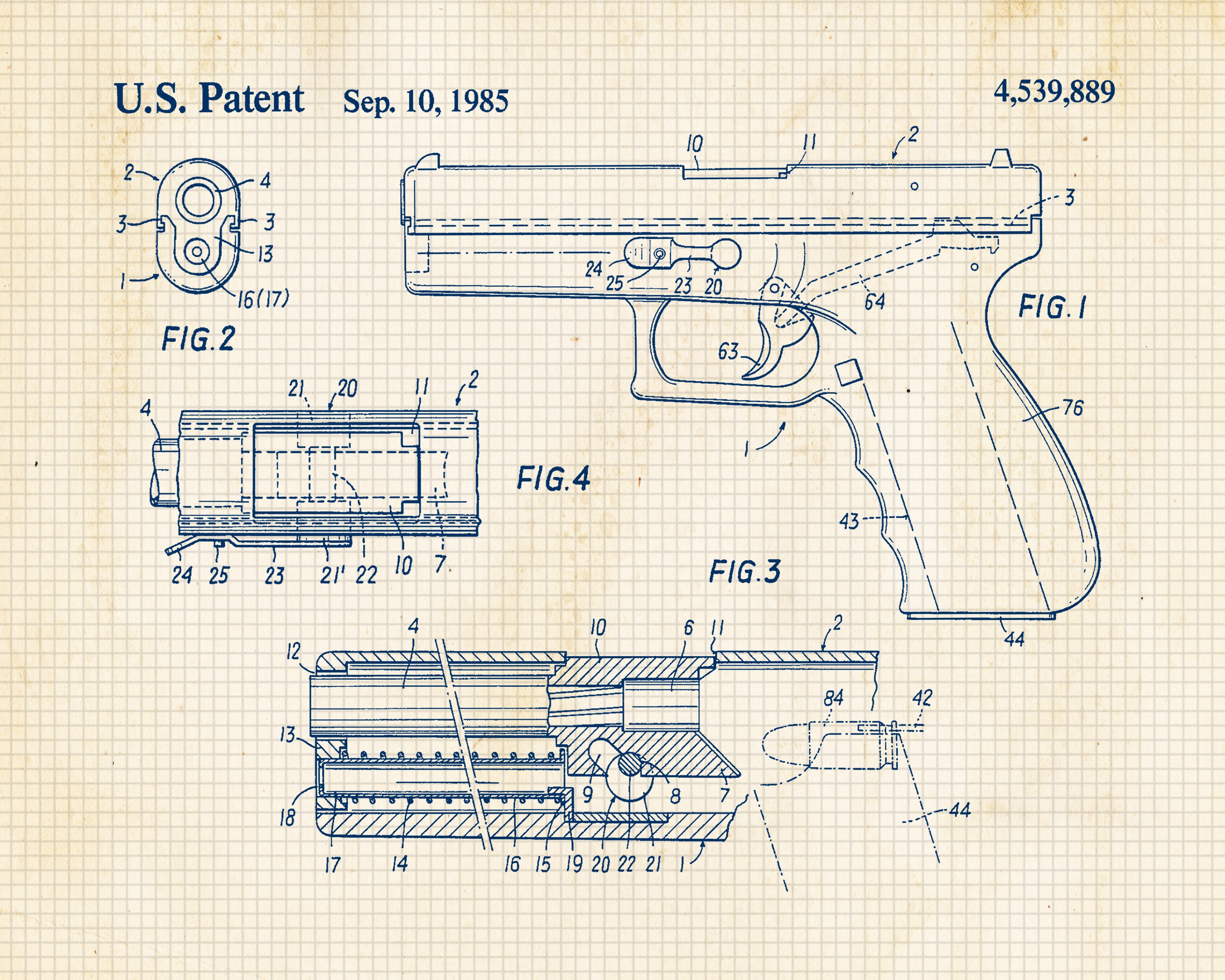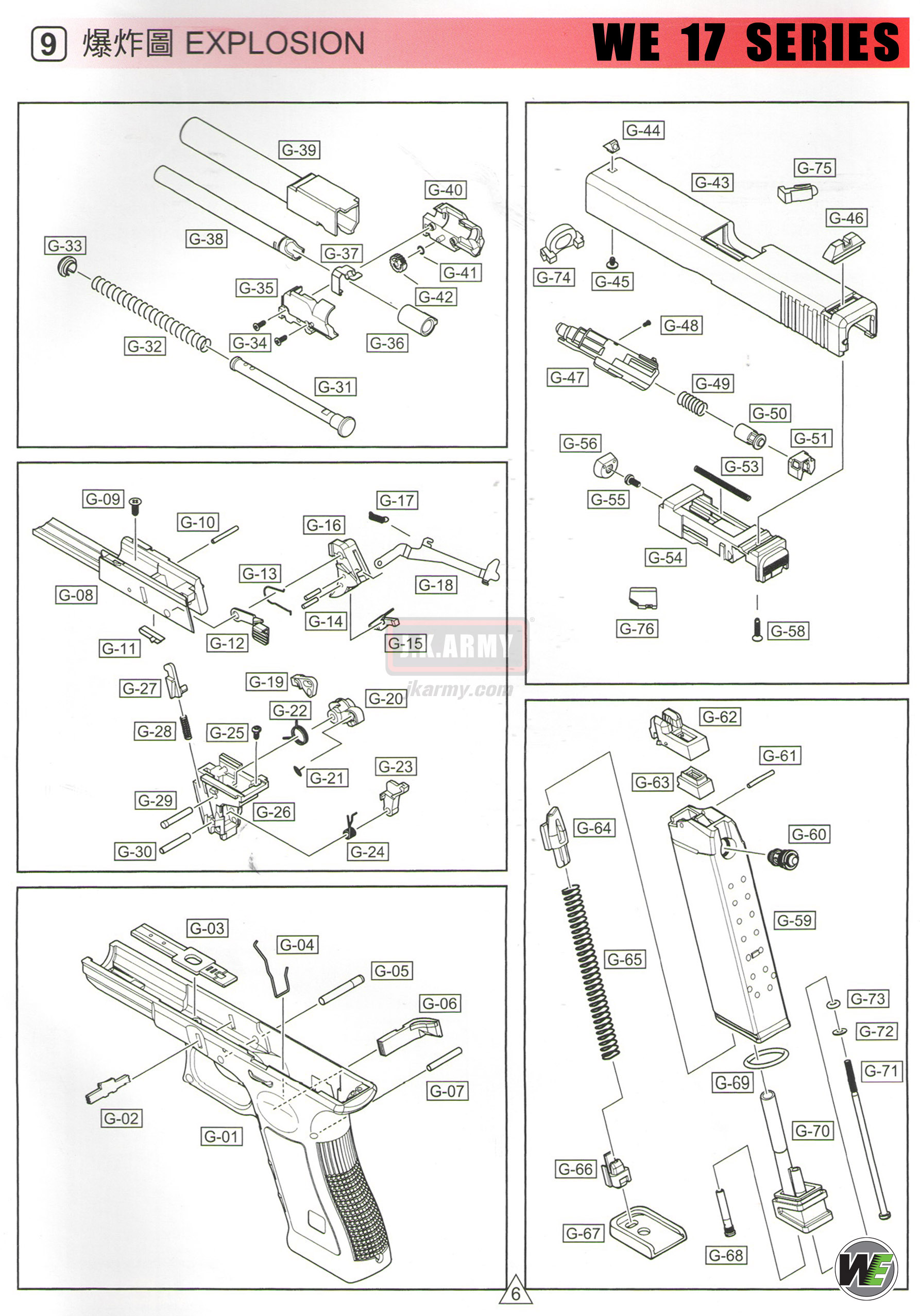Glock 17 Schematic - I want to believe that 1911 was the end of it all. But, I always found myself spending more time shooting the Glock than the Wilson. At 22 years old, and a young 11B, I'm not the ideal candidate for a 1911. To be honest, nearly a decade on and I've been given a 1911 or a Glock the entire time I've carried a pistol in the Army, I'm still not.
Sure, I can legally defend them now (thanks to LAV), I can photograph them well, and I love the craftsmanship and heritage that make for a quality 1911. They have
Glock 17 Schematic

As people like to say. But, I'm a realist; and I'd rather shoot my guns than clean or maintain them.
Over 15,000 Printable Gun Schematics (diagrams) And Blueprints For Antique And Modern Guns
[Note: Please welcome guest author Jon C., an active duty U.S. Army Special Forces soldier. This article was first published by Gray Group Training. We present it here with permission, slightly expanded and with photos.] more
[singlepic id=4083 w=500]Place yourself in a scenario where you are forced to use a gun and shoot 7 bullets. And then another target appeared. What's faster, reloading under extreme stress or just pulling the trigger again...10 MORE TIMES? (thanks to Bob M. for that one) The Glock is the gun for me.
I've recently witnessed many troubleshooting of Glock pistols by some uneducated colleagues of mine, and have seen countless examples of bad advice given by the "internet" about what makes a reliable task. Contrary to popular belief, not every commando is a gunman. A small percentage of commando gun people have professional knowledge of firearms, not just gun enthusiasts. My goal here is to break down the trigger into its individual parts, to understand how tweaking each can change the characteristics of the trigger (and the gun as a whole), and to give people the tools to select safe and reliable combinations of components. that will give the performance they want.
I'll be speaking in terms of the 9/40/.357 small-frame Glock because that's the one I'm most familiar with; and a size most Glock shooters will use. Most also carry 20/21. If you take the .45GAP I'm assuming it doesn't exist so I can't help you but the same guidelines apply. Here is a diagram of a Glock firearm showing the 33 factory parts, I will use the Glock nomenclature to reference this chart from Glock (used with permission) throughout the article for consistency:
Glock 17 Pistol Full Auto Conversion.pdf
This part interacts with many of the other parts we'll talk about, and most importantly the part that your finger interacts with when you shoot the gun.
[singlepic id=4106 w=320 h=240 float=none]Glock 17/22, 34/35, and 17L/24 have smooth surface triggers, left. The 26/27 and 19/23 triggers have vertically oriented cleats. They came this way to comply with BATF firearms import guidelines. Most people I know prefer the smooth faced trigger and often substitute the serrated version. The trigger guard is the vertical protrusion in the center of the trigger surface. Without stepping aside when your finger makes contact, the trigger is blocked from reverse motion and the gun cannot be fired.
[singlepic id=4094 w=280 float=none] Attached to this rotating trigger is the trigger blade. The trigger blade is a stamped piece of steel that engages the internals of the striker firing system in such a way as to disable the internal safety and allow the striker to travel along the firing pin chute and detonate the primer with the cartridge. Working from the trigger back to the first note item on the trigger bar itself is the vertical lobe above the bar. [singlepic id=4076 w=320 h=240 float=none] This is the point where the trigger blade lifts off the firing pin safety (#9). This section is also commonly called the striker block. When the trigger is pressed, this inflated lobe moves backwards, pushing the firing pin safety up. As the firing pin safety increases, it reveals a horizontal slot cut in its profile that aligns with the firing pin chute and allows the firing pin to advance freely into the primary of the round. This interaction is key when executing triggering tasks and will be discussed later. Moving to the end of the trigger bar, we come to the point where it connects to the aptly named connector (#24), trigger spring (#25), and trigger mechanism housing (#23). [singlepic id=4088 w=320 h=240 float=none] The cross-shaped protrusion behind the bar engages, engages, and releases the firing pin (#5). Although the Glock Safe Action doesn't have a true sear, the front of this trigger blade does the sear job because it is the point where the firing pin is released.

[singlepic id=4104 w=320 h=240 float=none]Generally when Glock shooters decide to change their trigger mechanism, the first thing they turn to is the trigger connector. The connector is a small piece of stamped metal that changes the weight of the trigger pull. It is pressed against the side of the trigger housing and the wide, curved lip angle of the connector determines the force required to cock and remove the firing pin. When the trigger blade moves back, the rounded end rides on the wide flange on the connector and is pressed down. The steeper the angle, the heavier the trigger.
Hgw For Glock Extractor Depressor Plunger Spring
[singlepic id=4100 w=320 h=240 float=none] The connector must not sit flush with the trigger housing in its channel. It seems slightly bent outward and that is normal. Don't try to bend it at a 90 degree angle. The connector must provide minimal external force to the trigger bar. A small flange at the top of the connector engages the track on the slide to release the trigger bar during reset.
*** ALL WEIGHTS AND FEELINGS ARE SUBJECT TO GUN TO GUN TO DEGREE. THIS IS A SEALED PART, IT IS NOT EASILY REMOVED AND HAS NO CONCLUSION IN ITS FEELING***
Glock makes 3 versions of the connector that I recommend for use in duty/defensive weapons. These are the Standard (5.5lb), Minus (4.5lb) and Connector5 (also known as the "Dot" (5lb). Glock makes a pair too rare to even consider, or too heavy on something like an 8.0lb (+ ) connector.
[singlepic id=3578 w=320 h=240 float=none] The standard (center) connector is on subcompact (26 ff.), compact (19 ff.) and full-size (17 etc.) guns. It used to be considered £5 by Glock but now they sell it as £5.5. It provides a decent drag when broken and mashed. They can be shot right out of the box or given a simple polish job. In any case it is a very reliable trigger.
Acp Pistol Diagram Poster Picture Vlueprint Schematic Kimber Colt 3016
The Minus connector (left) is present on both 35/35 and 17L/24 guns and offers a 4.5lb (previously 3.5lb) towing weight according to Glock technology specifications. When used with other factory parts, it also provides a reliable trigger and is easy to fire.
The Dot connector (right) is a newly developed part that works best with the redesigned trigger blade on Gen4 pistols. Reportedly a middle ground between standard and minus connectors due to the increased weight carried by the slightly modified Gen4 trigger bar. When used in conjunction with the Gen3 trigger bars, they provide slightly lighter, sharper breaks with a positive reset.
The only aftermarket connector I've seen that works properly is the non-adjustable Ghost connector, though I've heard anecdotal reports of the Lone Wolf connector working fine. Of particular note, Scherer connectors should be avoided at all costs. If in doubt, look for a factory Glock connector.

This piece is the quickest and easiest way to get different trigger pulls, and can be installed in minutes by any Glock shooter.
Browning Hi Power Handgun Gun Cleaning Mat 11\
Trigger spring is where the "give and take" of trigger pull is determined [singlepic id=4091 w=320 h=240 float=none] Trigger spring connects trigger rod to trigger housing via coiled "S" spring or plastic leaf spring with coil spring retainer (NY series). The interaction of these two springs is not exactly the same but the basic functions are similar, let's skip the engineering lesson. It is simply understood that the trigger spring actually pulls the connector to the back of the gun. The heavier the spring, the more it will help you pull the trigger.
The heavier (marketed as "lighter" due to its pulling effect) the trigger spring, the lighter the trigger pull. The "lighter" spring makes it easier to apply force to the trigger and move the trigger blade, but as a result, the "lighter" spring counteracts the trigger motion to reset. The "heavier" (actually lighter) spring results in a heavier trigger pull but the reduced spring resistance holds the trigger harder.
I have found me
Glock 17 kydex holster, glock 17 iwb holster, glock 19 schematic, glock 17 serpa holster, glock 43 schematic, glock 17 holsters, safariland glock 17, glock schematic, glock 17 holster, glock parts schematic, glock schematic pdf, cleaning a glock 17